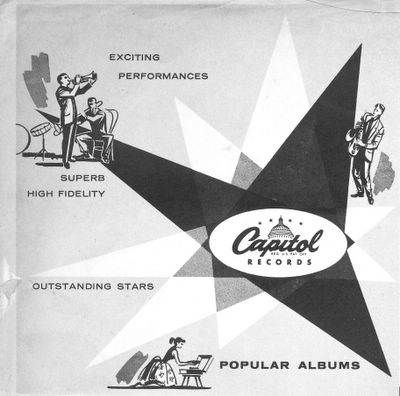
I've got to start looking closer at my records, both inside and out. I was in the process of putting away the Red Nichols LP I just featured when I happened to pull the record out of the sleeve. Well, the inner sleeve didn't come out with it like I expected, so I reached in and pulled it all the way out, and there in my hand were all the doodles you see here. Seven different vignettes of life at Capitol Records circa 1956, as well as an advertisement for a magazine I'd never heard of published by Capitol, and an advertisement for T-Rim, a little manufacturing trick that they used to make a big deal about. For you record buffs, there is also a rather lengthy list of then-current offerings on Capitol, including Frank Sinatra, Les Baxter, Duke Ellington, Louis Prima, Benny Goodman, Jackie Gleason, Les Paul, Stan Kenton, Kay Starr, Yma Sumac, Billy May, the list just goes on and on. I placed a date of 1956 on this, since the LP I found it in claims it was recorded in September of 1956, but it may not have been released until the following year. I'm pretty sure it's no later than that, because none of the records listed say anything about being available in stereo. So, have a look at the doodles, and there's a picture of a large corner from the sleeve, showing the Capitol logo and some of the doodles in their original context. Enjoy!






The big picture below is from one corner of the inner sleeve, maybe a 7" square chunk of it. I also found this website that talks about these inner sleeves, and even has a full scan of this same sleeve.

There's also a small blurp about Music Views, a monthly magazine available from your record dealer. I assume this was put out by Capitol since it's hyped on their sleeve, but I really have no idea. Time to have a go at Google...

Last but not least, here's the T-Rim logo. I think I blogged about this last year, but I'll have to look. Basically, it meant that the edges of the record were raised above the playing surface, so when you changer dropped the next record on the last, it hit that raised edge, and not the grooves. Maybe it was a big deal after the fragile 78's of a few years earlier.


















